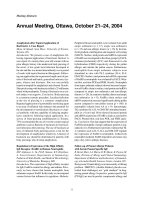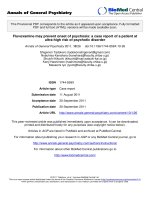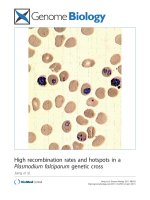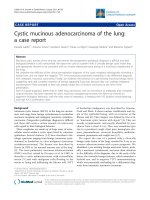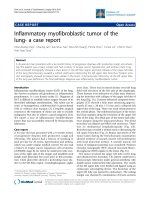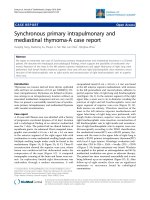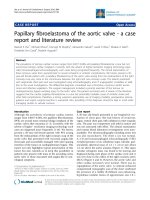Báo cáo y học: " Multifocal multi-organ ischaemia and infarction in a preterm baby due to maternal intravenous cocaine use: a case report" ppsx
Bạn đang xem bản rút gọn của tài liệu. Xem và tải ngay bản đầy đủ của tài liệu tại đây (318.35 KB, 4 trang )
BioMed Central
Page 1 of 4
(page number not for citation purposes)
Journal of Medical Case Reports
Open Access
Case report
Multifocal multi-organ ischaemia and infarction in a preterm baby
due to maternal intravenous cocaine use: a case report
Ben C Reynolds*
1
, Dawn MK Penman
2
, Allan G Howatson
2
,
Lesley A Jackson
1
and Charles H Skeoch
1
Address:
1
Neonatal Unit, Princess Royal Maternity Hospital, Alexandra Parade, Glasgow, UK and
2
Department of Paediatric Pathology, Royal
Hospital for Sick Children, Dalnair Street, Glasgow, UK
Email: Ben C Reynolds* - ; Dawn MK Penman - ;
Allan G Howatson - ; Lesley A Jackson - ;
Charles H Skeoch -
* Corresponding author
Abstract
Introduction: Although the adverse effects of cocaine use in pregnancy are well recognised, we
believe this case highlights the importance of considering the route of administration, and suggests
the possibility of multifocal damage relating to intravenous use.
Case presentation: A Caucasian female baby of 29-weeks' gestation was spontaneously delivered
and subsequently developed multi-organ failure considered unrelated to simple prematurity.
Intensive care was re-orientated following the development of massive intraventricular
haemorrhage.
Conclusion: This case illustrates the need for regular cranial ultrasound in babies of pregnancies
at risk due to intravenous cocaine use and also the necessity of counselling women who misuse
cocaine in the antenatal period. As such, this article will be of most interest to paediatric and
obstetric staff.
Introduction
Cocaine use in pregnancy has been associated with
adverse fetal outcomes including congenital malforma-
tions. We report a female baby of 29 weeks' gestation
whose mother had extensive polydrug misuse throughout
her pregnancy, including the use of intravenous cocaine.
Following spontaneous delivery, the baby died after three
days of intensive support. A post-mortem examination
revealed widespread ischaemic change throughout multi-
ple organs. We hypothesise that the unusual extent of this
damage is related to the route of administration and dos-
age of cocaine during the pregnancy.
Case presentation
A 29-year-old Caucasian primigravida presented at 29
+0
weeks' gestation with abdominal pain and fever. A pre-
sumptive diagnosis of urinary tract infection was made
with laboratory investigations demonstrating a raised C-
reactive protein and peripheral leukocytosis, and treat-
ment with intravenous cefuroxime was commenced. The
expectant mother reported regular use of heroin,
diazepam, 'street' methadone and cocaine. Heroin and
cocaine were both smoked and injected intravenously.
Frequency of use was difficult to clarify.
Published: 10 December 2009
Journal of Medical Case Reports 2009, 3:9324 doi:10.1186/1752-1947-3-9324
Received: 23 September 2008
Accepted: 10 December 2009
This article is available from: />© 2009 Reynolds et al; licensee BioMed Central Ltd.
This is an Open Access article distributed under the terms of the Creative Commons Attribution License ( />),
which permits unrestricted use, distribution, and reproduction in any medium, provided the original work is properly cited.
Journal of Medical Case Reports 2009, 3:9324 />Page 2 of 4
(page number not for citation purposes)
Abdominal pain continued intermittently and antenatal
betamethasone was administered. A cardiotocograph
(CTG) trace was non-reassuring and necessitated an emer-
gency Caesarean section approximately five hours after
the initial dose of betamethasone. A female was delivered
alive and in good condition, weighing 1530 g (75
th
cen-
tile). Apgar scores were 7
1
and 8
5
. There were no external
dysmorphic features, organomegaly, rash or bleeding. An
initial cranial ultrasound scan was normal with no evi-
dence of haemorrhage. Mean blood pressure (BP) was
normal. Laboratory investigations demonstrated marked
coagulopathy and abnormal liver function tests (Table 1).
Aspartate transaminase (AST) was disproportionately ele-
vated in comparison with other liver enzymes, a pattern
suggesting extensive tissue injury due to the non-specifi-
city of AST.
Fresh frozen plasma (FFP) and cryoprecipitate were
administered without improvement in the coagulopathy.
Urine was noted to be pink in colour, but microscopy did
not demonstrate red cells. At 16 hours of age, there was
generalised seizure activity confirmed on amplitude-inte-
grated EEG (Cerebral Function Monitoring - 'CFM'). The
infant was loaded with phenobarbitone and received a
half correction of sodium bicarbonate for a progressive
metabolic acidosis. Morphine was infused at 10 micro-
grams/kg/hour.
Urine output was <0.5 ml/kg/day by 24 hours of age and
she was passing extremely liquid stools. Coagulopathy
persisted and liver function deteriorated further on
sequential monitoring (Table 1). Repeat ultrasound at 36
hours of age showed bilateral intraventricular blood with
evidence of marked midline shift. It was decided that con-
tinuing care aimed at the baby's survival was inappropri-
ate and care was re-orientated following discussion with
the baby's mother. The infant was extubated one hour fol-
lowing baptism, and died shortly afterwards.
A postmortem examination was performed and it demon-
strated intraventricular haemorrhage (IVH) (Figure 1)
expanding all four ventricles and extending around the
brain stem and cerebellum (grade 3). Histology showed
recent subarachnoid haemorrhage and cortical vascular
congestion consistent with multiple small focal interstitial
haemorrhages distinct from the IVH. There was hepatic
necrosis (Figure 2) and evidence of colonic mucosal
ischaemic injury with multiple punctate erythematous
areas. The kidneys showed zonal interstitial haemorrhage
involving the medullary pyramids. The bladder also con-
tained an area of large submucosal haemorrhage. These
urogenital changes probably explain the pink-coloured
urine. The absence of red cells was possibly attributable to
haemolysis within the urinary tract. In addition, there was
ischaemia and necrosis of the islets of Langerhans with
sparing of the exocrine pancreas. Thymus, heart and
Table 1: Temporal evolution of laboratory parameters.
Laboratory parameter Age
Parameter Reference Range 1 hour 12 hours 36 hours
PT 10.6-16.2 secs 54 29
APTT 27.5-79.4 secs 60 41
TCT 19.2-30.4 secs 23 19
Fibrinogen 1.5-3.73 g 0.5 1.2
Urea 2.5-7.5 mmol/l 6.4 9.5
Creatinine 35-100 μmol/l 78 136
Bicarbonate 21-28 mmol/l 22.0 15.6 13.1
AST <40 U/l 1891 2168
ALT <50 U/l 200 203
Gamma-GT <55 U/l 259 227
Albumin g/l 21 17
Stated coagulation reference ranges are applicable to 30-week
gestation healthy controls on the first day of life.
ALT, alanine transaminase; APTT, activated partial thromboplastin
time; AST, aspartate transaminase; Gamma GT, gamma glutamyl
transferase; PT, prothrombin time; TCT, thrombin clotting time.
Bilateral blood casts of cerebral ventriclesFigure 1
Bilateral blood casts of cerebral ventricles. Post-mor-
tem pathological specimen demonstrating 'cast' formed by
cerebral ventricles entirely filled with blood following mas-
sive intraventricular haemorrhage.
Journal of Medical Case Reports 2009, 3:9324 />Page 3 of 4
(page number not for citation purposes)
adrenals appeared normal. Examination of the placenta
showed acute decidual haemorrhage and chronic intervil-
litis. Microbiological and metabolic investigations did not
demonstrate any further cause for deterioration or death.
Discussion
Cocaine has been used for recreational purposes for over
5000 years [1]. The drug can be ingested, smoked, injected
or inhaled intranasally. Smoking and snorting cocaine are
the most common methods of cocaine use. Intravenous
use is infrequent and account for less than 10 percent of
cocaine use in the USA [2]. Comparative figures for the
UK are unavailable and comprehensive Department of
Health public information only briefly mentions injec-
tion as a route of administration [3].
Adverse effects of cocaine on the adult user are well recog-
nised [1]. Vasoconstrictive effects are mediated via block-
age of catecholamine uptake and beta-adrenergic
stimulation. Cocaine use during pregnancy and its tera-
togenic effects on the fetus are less well defined. Early
observational reports suggested 'crack babies' could have
a variety of congenital abnormalities, including gastro-
schisis, intraventricular haemorrhage, growth restriction,
and genitourinary and renal anomalies [4]. While evi-
dence has increased, meta-analyses [5] and larger scale
studies [4] have not confirmed any of the anatomical
sequelae, although behavioural effects appear true. The
mode of cocaine use is rarely considered or controlled for,
nor is the cumulative dose of cocaine. Polydrug use and
the chaotic lifestyle associated with substance misuse are
variably considered as confounding within studies. Matu-
rity at birth is also often omitted though it is suggested
that preterm babies are affected differently [6].
The role of cocaine in intraventricular haemorrhage is still
unclear. A prospective study [7] comparing light and
heavy cocaine users with controls demonstrated an
increased incidence of subependymal haemorrhage
within term babies in the heavy cocaine user group only.
A subsequent retrospective review [8] found a similar
finding in preterm babies. Although, the review did not
stratify according to cocaine usage, it suggested that this
effect may have been even more pronounced in mothers
who used large quantities. A small prospective study [9] of
very low birth weight (VLBW) babies showed a higher
incidence of grade I to II haemorrhage, but not more
severe bleeds. A further larger prospective study of VLBW
babies [10] did not find any increased risk of grade III or
IV intraventricular haemorrhage though it did not con-
sider dosage for confounding or consider smaller bleeds.
Widespread focal ischaemia and infarction affecting mul-
tiple organs has not previously been reported in an infant
as a result of maternal cocaine use. We hypothesise that
the postmortem findings are related to the vasoconstric-
tive effects of cocaine use. The occurrence or extent of
intraventricular haemorrhage within cocaine-exposed
babies may be related to dosage. Intravenous usage may
aggravate this effect. This case is of particular interest due
to the widespread nature of the ischaemic infarcts affect-
ing multiple organ systems. The focal nature of the inf-
arcts affecting multiple organs makes them highly
unlikely to be attributable to either complications of pre-
maturity or the other illicit substances taken during this
pregnancy. Due to the mixed nature, another substance or
a cumulative effect cannot be excluded. However, similar
infarcts have not, to our knowledge, been reported with
heroin, methadone, or benzodiazepine use.
Conclusion
We advocate early and regular coagulation screening and
cranial ultrasound scans for pregnant women with signif-
icant cocaine use, particularly if taken intravenously. The
risk of significant morbidity and mortality should be con-
sidered during antenatal counselling of women who use
cocaine. We also suggest that there is a need for further
prospective research in this area with dosage and mode of
administration being considered as confounding factors.
Abbreviations
ALT: alanine transaminase; APTT: activated partial throm-
boplastin time; AST: aspartate transaminase; BP: blood
pressure; CFM: cerebral function monitoring; CTG: cardi-
otocograph; EEG: electroencephalogram; FFP: fresh fro-
A clear demarcation of healthy liver on the left, ischaemic liver centrally, and necrotic areas to the rightFigure 2
A clear demarcation of healthy liver on the left,
ischaemic liver centrally, and necrotic areas to the
right. Postmortem pathological specimen of liver demon-
strating zonal multifocal necrosis, with marked macroscopic
necrosis visible on right side of specimen, healthy liver on left
and a 'border' of ischaemic tissue between.
Publish with Bio Med Central and every
scientist can read your work free of charge
"BioMed Central will be the most significant development for
disseminating the results of biomedical research in our lifetime."
Sir Paul Nurse, Cancer Research UK
Your research papers will be:
available free of charge to the entire biomedical community
peer reviewed and published immediately upon acceptance
cited in PubMed and archived on PubMed Central
yours — you keep the copyright
Submit your manuscript here:
/>BioMedcentral
Journal of Medical Case Reports 2009, 3:9324 />Page 4 of 4
(page number not for citation purposes)
zen plasma; GGT: gamma glutamyl transferase; IVH:
intraventricular haemorrhage; PT: prothrombin time;
TCT: thrombin clotting time; VLBW: very low birth
weight.
Consent
Written informed consent was obtained from the parent
of the patient for publication of this case report and
accompanying images. A copy of the written consent is
available for review by the Editor-in-Chief of this journal.
Competing interests
The authors declare that they have no competing interests.
Authors' contributions
BCR and LAJ were the principal contributors to the man-
uscript, and primarily involved in the care of the baby.
DKMP and AGH performed the postmortem and kindly
provided the figures. CHS revised the manuscript. All
authors read and approved the final manuscript.
References
1. Warner EA: Cocaine abuse. Ann Int Med 1993, 119(3):226-235.
2. Substance Abuse and Mental Health Services Administration: The
DASIS report: Cocaine Route of Administration Trends: 1995-2005 Rock-
ville MD: Office of Applied Studies; 2007.
3. 'Talk to Frank'. Department of Health [ktof
rank.com]
4. Bauer CR, Langer JC, Shankaran S, Bada HS, Lester B, Wright LL,
Krause-Steinrauf H, Smeriglio VL, Finnegan LP, Maza PL, Verter J:
Acute neonatal effects of cocaine exposure during preg-
nancy. Arch Pediatr Adolesc Med 2005, 159:824-834.
5. Addis A, Moretti ME, Syed FA, Einarson TR, Koren G: Fetal effects
of cocaine: an updated meta-analysis. Reproductive Toxicology
2001, 15:341-369.
6. Brown JV, Bakeman R, Coles CD, Sexson WR, Demi AS: Maternal
drug use during pregnancy: are preterm and full-term
infants affected differently? Developmental Psych 1998,
34(3):540-554.
7. Franck DA, McCarten KM, Robson CD, Mirochnick M, Cabral H, Park
H, Zuckerman B: Level of in utero cocaine exposure and neo-
natal ultrasound findings. Pediatrics 1999, 104:1101-1105.
8. Smith LM, Qureshi N, Renslo R, Sinow RM: Prenatal cocaine
exposure and cranial sonographic findings in preterm
infants. J Clin Ultrasound 2001, 29(2):72-77.
9. Singer LT, Yamashita TS, Hawkins S, Cairns D, Baley J, Kliegman R:
Increased incidence of intraventricular haemorrhage and
developmental delay in cocaine-exposed, very low birth
weight infants. J Pediatr 1994, 124(5 Pt 1):765-771.
10. Dusick AM, Covert RF, Schreiber MD, Yee GT, Browne SP, Moore
CM, Tebbett IR: Risk of intracranial haemorrhage and other
adverse outcomes after cocaine exposure in a cohort of 323
very low birth weight infants. J Pediatr 1993, 122(3):438-445.
